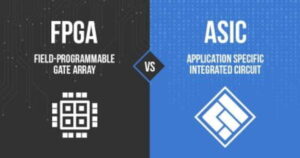Introduction
In the world of Very Large Scale Integration (VLSI) design, the choice of coding languages is pivotal for efficient design and verification processes.
VLSI engineers rely on both Hardware Description Languages (HDLs) for modeling hardware and scripting languages for automation and additional functionality.
Why Coding languages in VLSI
Verilog and VHDL are critical in VLSI design for several reasons:
1. Hardware Design Specification
- Verilog: Allows designers to describe the behavior and structure of digital systems at various levels of abstraction, from high-level behavioral descriptions to low-level gate representations.
- VHDL: Offers a comprehensive and versatile way to model the behavior and structure of electronic systems, providing strong support for design reuse and modularity.
2. Simulation and Verification
- Both Verilog and VHDL enable simulation of digital circuits before physical implementation, allowing designers to verify the correctness of the design and identify errors early in the development process. This is crucial for ensuring functionality and performance meet the required specifications.
3. Synthesis
- These languages are synthesizable, meaning they can be translated into gate-level netlists by synthesis tools, which can then be mapped to physical hardware (e.g., FPGAs, ASICs). This capability bridges the gap between abstract design and physical implementation.
4. Industry Standardization
- Verilog: Widely adopted in the industry, especially in the United States, for designing complex digital systems. It is supported by numerous EDA (Electronic Design Automation) tools.
- VHDL: Also an industry-standard language, particularly in Europe and defense industries, and supported by major EDA tools, ensuring broad compatibility and interoperability.
5. Modularity and Reusability
- Both languages support modular design practices, allowing designers to create reusable components, which can be integrated into larger systems. This enhances productivity and reduces design time.
6. Flexibility and Expressiveness
- Verilog: Known for its straightforward syntax and ease of learning, making it accessible for both beginners and experienced designers.
- VHDL: Offers strong typing, rigorous syntax, and extensive libraries, providing a robust framework for complex and large-scale designs.
7. Community and Ecosystem
- Both Verilog and VHDL benefit from large communities of designers, extensive documentation, and a wealth of third-party resources, which facilitate learning, troubleshooting, and innovation in VLSI design.
8. Standardization Bodies
- Verilog: Standardized as IEEE 1364, ensuring consistent language specifications and updates.
- VHDL: Standardized as IEEE 1076, providing a stable and consistent language definition for designers globally.
In summary, Verilog and VHDL are indispensable in VLSI design due to their ability to model, simulate, verify, and synthesize digital circuits, their widespread industry adoption, and their support for modular and reusable design practices.
This blog post delves into the most prominent languages used in VLSI, highlighting their strengths, weaknesses, and ideal use cases.
Follow us on Twitter: https://x.com/TechoVedas
1. Hardware Description Languages (HDLs)
Verilog
Syntax: Verilog’s syntax resembles the C programming language, making it approachable for those with a background in C or similar languages.
Strengths:
Concise Code: Verilog allows for efficient representation of complex logic, enabling designers to write compact and readable code.
Scalability: It can handle large and hierarchical designs effectively, making it suitable for a wide range of projects.
Verification: Verilog includes constructs that support built-in verification methodologies, aiding in the validation of designs.
Weaknesses:
Weak Typing: Verilog’s weak typing can lead to runtime errors if not used carefully, requiring designers to be vigilant.
Error Handling: It has limited mechanisms for robust error handling, which can be a drawback in complex designs.
Read More: 3 Reasons Why Quantum Computing Will Challenge VLSI Design
2. VHDL
Syntax: VHDL’s syntax is based on the Ada programming language, known for its formal and strict approach.
Strengths:
Strong Typing: VHDL enforces data type consistency, significantly reducing the risk of errors.
Readability: Its structured nature encourages well-documented and organized code, improving readability.
Concurrency: VHDL supports concurrent processes, which is essential for modeling complex behaviors in hardware design.
Weaknesses:
Learning Curve: The strict syntax and formality result in a steeper learning curve compared to Verilog.
Verbosity: Simple designs can become verbose, leading to longer code compared to Verilog.
3. SystemVerilog
Extends Verilog: SystemVerilog enhances Verilog by adding advanced verification features, assertions, and integration with the Universal Verification Methodology (UVM).
Benefits:
Increased Capabilities: SystemVerilog enables more complex verification scenarios and design reuse, enhancing overall design quality.
Enhanced Productivity: Purpose-built constructs streamline verification tasks, boosting productivity.
Considerations:
Learning Curve: Understanding Verilog is a prerequisite before diving into SystemVerilog.
Tool Support: Ensure your Electronic Design Automation (EDA) tools fully support SystemVerilog features for optimal performance.
4. Scripting Languages
Python
General-purpose Language: Python’s versatility extends beyond scripting, making it valuable for data analysis, machine learning, and more.
Strengths:
Ease of Use: Python’s simple syntax and extensive community support make it easy to learn and use.
Extensive Libraries: A wide range of libraries supports various tasks in VLSI design.
Interoperability: Python integrates well with popular EDA tools, enhancing its utility in VLSI workflows.
Weaknesses:
Performance: Python may be slower than lower-level languages for performance-critical tasks, which can be a limitation in certain scenarios.
Read More:IBM and Pasqal Forge Open-Source Path to Build Practical Quantum Supercomputers. – techovedas
5. Perl
Text Processing Power: Perl excels in tasks like file manipulation and parsing log data, making it a powerful tool for text processing.
Strengths:
Regular Expressions: Perl’s powerful regular expression capabilities facilitate complex text processing tasks.
Conciseness: Tasks can often be accomplished with fewer lines of code compared to Python.
Weaknesses:
Readability: Perl’s syntax can be less readable, especially for beginners, compared to Python.
Mature Language: Perl sees less active development compared to Python, which may limit access to new features and libraries.
Read More: MIT Develops Breakthrough Technique for Training Multipurpose Robots – techovedas
6. Tcl
Scripting Language for EDA Tools: Tcl is often embedded within EDA tools for automation, providing seamless integration.
Strengths:
Tight Integration: Tcl’s seamless interaction with specific EDA tool features enhances its utility.
Ease of Use: Its relatively simple syntax makes Tcl easy to learn for beginners.
Weaknesses:
Less General-purpose: Tcl is primarily used within EDA tools, limiting its applications outside this domain.
Community: Tcl has a smaller community compared to Python or Perl, which can affect the availability of learning resources and support.
Read More: 8 Reasons Why Neuromorphic Computing Demands a Revolution in Chip Design
Additional Considerations
Learning Resources
The availability of tutorials, documentation, and online communities is crucial for learning any language. Verilog, VHDL, and Python boast extensive learning resources, while Tcl and Perl have more niche communities.
Industry Trends
Verilog and SystemVerilog remain dominant in the industry for hardware design and verification. Python is increasingly popular for scripting tasks due to its versatility and ease of use. VHDL continues to be favored for projects requiring strong typing and concurrency.
Conclusion
The best language choice depends on the specific project requirements and your team’s expertise. A well-rounded VLSI engineer should be proficient in both HDLs and scripting languages to maximize efficiency and productivity. By understanding the strengths and weaknesses of each language, you can make informed decisions that enhance your VLSI design and verification processes.








